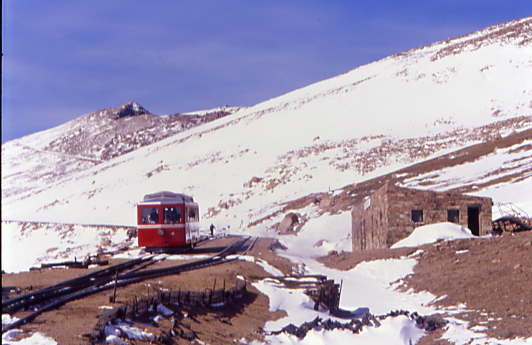
Chris Parker and I left the Pikes Peak Historical Street Railway in Colorado Springs and retraced our route back to Interstate 25 then south to US 24 West towards Manitou Springs. We took the exit for Manitou and drove up the hill into town.
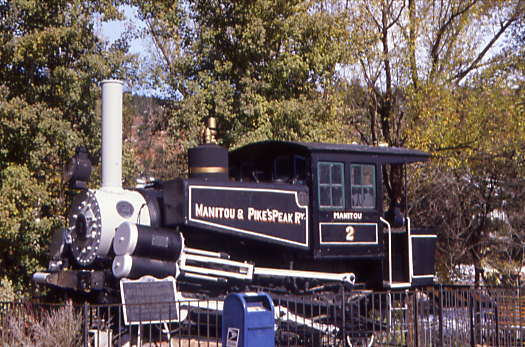
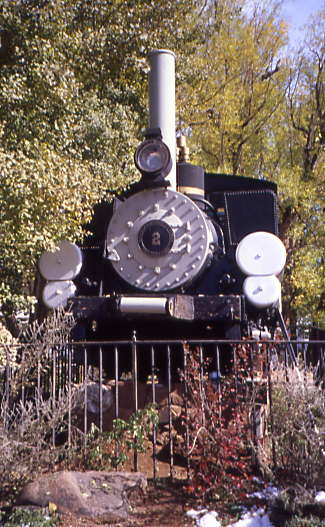
Manitou and Pikes Peak Railway 0-4-0T cog 2 "Manitou" built by Baldwin in 1890 on display. It started life as a simple expansion locomotive named "Manitou" and then "T. F. Richardson. The steam engine continued working on the grade until 1940, when it was donated to the city of Manitou Springs.
The 8.9 mile standard gauge line to Pike's Peak was built as a tourist-only line beginning in 1889, with a limited service to the Halfway House Hotel completed by 1890, and the 14,110 foot summit was reached the following year. The Manitou Incline was built in 1907 to construct city water lines and a hydro-electric plant, after which, the M&PP took it over as a funicular incline. The lower terminus was next to the Cog Railway station in Manitou Springs, but the line was closed by a rock slide in 1990 and has not reopened.
During the 1930's, the M&PP began investing in new motive power. In 1938, it built a twenty-four passenger, 175 hp gas-powered "Streamliner", 7, at its workshops. This worked well and GE was then contracted in 1939 to build 8, the first of five diesel-electric cog locomotives delivered between 1939 and 1956 that progressively replaced the steam engines.
We turned left on Ruxton Avenue and proceeded through town to the parking area of the Manitou & Pike's Peak Railway.

Manitou and Pikes Peak Railway 0-4-0T cog 2 "Manitou" built by Baldwin in 1901 on display at the depot. We walked down the parking lot to the station.
The Manitou and Pikes Peak Railway station built in 1891.
Here is where I picked up Chris Parker's and my tickets for our trip this afternoon.
A look down at the station area.
Looking towards the shops.
The shop area.
One of the GE cars sitting outside that is used mainly for work train service. I walked down to the railroad's offices and met Spencer Wren, Jr. and inquired about a shop tour for my story. He said to return in ten minutes and he would escort me. I found Chris, who had just ordered lunch, and he told me to take the tour.
What is a "Cog" Railway?Conventional railroads use the friction of wheels upon the rails, called "adhesion," to provide locomotive power. A cog, or rack, railroad uses a gear, or cog wheel, to mesh into a special center rack rail to climb much steeper grades than those possible with a standard adhesion railroad. An adhesion railroad can only climb grades of four to six percent, with very short sections of up to nine percent. A "rack" railroad can climb grades of up to 48 percent, depending upon the type of rack system employed. Some Swiss trains use a combination of "rack" and "adhesion" systems, enabling the trains to reach much higher speeds on the adhesion sections. The majority of rack railroads cannot go much faster than 15 miles per hour or they run the risk of dislodgement from the rack rail - the top speed of the Pikes Peak Railway is about nine miles and hour. The Manitou & Pikes Peak Railway uses a double cog, or Abt, system.
The first cog railway was built in New Hampshire in 1869. The Swiss, seeing the benefits of such a system, were quick to make use of this technology and numerous rack railways were built in Switzerland. Indeed, Switzerland is the country where most rack railways are located. The Pikes Peak Railway, however, is the highest rack railway in the world as well as the highest railway in North America and the Northern Hemisphere. The Pikes Peak Railway also has a perfect safety record!
History of the TrainsIn the late 1880's, one of the tourists who visited the Pikes Peak Region was Zalmon Simmons, inventor and founder of the Simmons Beautyrest Mattress Company. Mr. Simmons rode to the summit of Pike's Peak on a mule, partly to enjoy the view and partly to check upon one of his inventions: an insulator for the telegraph wires that ran to the Army Signal Station on the Summit. In those days, the arduous, two day trip on a mule was the only way to reach the top. Mr. Simmons was awed by the scenery but determined that the views should be experienced in a more civilized and comfortable manner. He was relaxing in one of Manitou Springs' mineral baths after his return, when the owner of his hotel mentioned the idea of a railway to the top. Mr. Simmons agreed with the concept and soon after set about providing the capital needed to fund such a venture.
In 1889, the Manitou and Pikes Peak Railway Company was founded and track construction began in earnest. Top wages were 25 cents an hour with six workers dying in blasting and construction accidents. The Age of Steam dominated the late 1800s, and in 1890, three engines from Baldwin Locomotive Works in Philadelphia, Pennsylvania were delivered. Limited service was initiated in that year to the Halfway House Hotel. These locomotives were eventually converted to operate using the Vauclain Compound system (with two cylinders, one high pressure and one low), and a total of six engines were in service during the "steam" era. The original three engines were named "Pikes Peak," "Manitou," and "John Hulbert," but were soon assigned numbers. Of the original six, only four are still operational and, along with a restored coach, is able to make infrequent trips short distances up the track.
The spring of 1891 was a snowy one, and the opening of the line was delayed until late June. On the afternoon of June 30th, 1891, the first passenger train, carrying a church choir from Denver, made it to the summit of Pikes Peak by train. A previously scheduled group of dignitaries had been turned back earlier in the day by a rock slide around 12,000 feet. Regardless, the railway was now operational!
A new era began in the late 1930's with the introduction of gasoline and diesel powered locomotives. Spencer Penrose, owner of the Broadmoor Hotel, had acquired the Railway in 1925 and efforts were underway to build a compact, self-contained railcar, which could carry fewer passengers during the slow parts of the season. These efforts culminated in engine No. 7: a gas-powered, 23-passenger unit, which made its first run on June 16, 1938. It is believed that No. 7 is the first rack railcar ever built in the world.
The experiment was a huge success, and within a year of No. 7's debut, No. 8, possibly the world's first diesel-electric cog locomotive was delivered from the General Electric Company. These diesel locomotives eliminated the time-consuming water stops as well as the back-breaking job of shoveling coal. Coupled with "Streamliner" coaches, Nos. 8, 9, 10, 11, and 12 formed the backbone of the Railway's fleet from 1940 through 1965. The coaches could carry 56 passengers in comfort and style.
The modern age of the Manitou & Pikes Peak Railway began with the requisition of railcars from the Swiss Locomotive Works in Winterthur, Switzerland. In the early 1960's, as tourism began to increase in Colorado, the Railway needed additional equipment, but the General Electric Company was not interested in the project. With that in mind, Mr. Thayer Tutt, President of the Railway, traveled to Switzerland to arrange for modern railcar acquisitions. The first units to arrive from Switzerland were Nos. 14 and 15, which were put into service in 1964. They proved so successful that soon after, the Railway ordered two more nearly identical units, Nos. 16 and 17. These Swiss railcars are self- contained units, powered by two Cummins diesel engines mounted underneath the seating area. As with the GE locomotives, they are diesel-electric trains. Generators driven by the diesel engines provide the power to traction motors for the ascent. For the descent, the diesel engines are shut down and the traction motors work as generators. Heat is disippated by resistor banks on the roof of the railcars.
Bigger units were needed as tourism continued to grow into the 1970s. The Manitou and Pikes Peak Railway officials returned to Swiss Locomotive Works in 1974 with a request for a train which could carry over 200 people. The results were the articulated railcars Nos. 18 and 19. These cars resemble the smaller single units but are joined by a "bellows" in the middle. In addition to capacity and size, a key difference between the two trains is that the larger units are diesel-hydraulic. Power is provided by a transmission/retarded made by Voith Turbo of Germany. Somewhat like the smaller units, the engines must idle on the return trip. These units originally came equipped with a TwinDisc transmission and a stand-alone retarder by Voith. These have now been replaced with the Voith T211rzze transmission which functions as a transmission going up and a retarder coming down. These first two modern railcars were put into service for the 1976 season with Nos. 24 and 25 being added in 1984 and 1989, respectively.
As an adjunct to the arrival of the first big Swiss railcars, new switches were installed along the line. Prior to 1976, trains departed the Manitou Depot only three times a day in the summer. The equipment needed to transport the passengers at the depot was brought down from the shop, loaded up, and arrived with the train at the summit. With the addition of new sidings at Minnehaha and Windy Point, trains can now run up to eight times per day and pass along the line. Now, trains depart in mid-summer, every eighty minutes, from 8:00 am until 5:20 pm.
In the mid-1960s, a young Swiss engineer by the name of Martin Frick was hired from Swiss Locomotive Works. Over the next 30 years, Mr. Frick brought the Railway into the modern age. The Manitou & Pikes Peak Railway is deeply indebted to Mr. Frick for his years of dedication and hard work. In addition to the first 80 passenger railcars, he did a major expansion of the shop facilities; oversaw the installation of new, modern electric and manual switches both in the yard and along the line; designed and built snowplow #22 with shop personnel; helped with the design and supervision of the acquisition of four 214-passenger railcars; and many other improvements too numerous to mention. As of April 2005, Mr. Frick continues to help with Swiss and German transactions and offers expert advice.
MaintenanceSince we're closed five days a week in the winter, a lot of people ask, "What do you people do all winter?!" In reality, the winters are actually busier than the summers. Although we only run one trip a day in the winter, versus up to 12 in mid-summer, our mechanics are up to their elbows in grease, diesel fuel, and train parts. We defer all major maintenance on the trains until things slow down. In the mid-summer, we have our hands full running eight daily departures of up to twelve trains total to the top of the Peak. But when things begin to slow down, the real dirty work begins and dirty is no joke!
In addition to the rigorous routine maintenance every unit receives, we do various other jobs in the winter, like changing cog wheels. The steel tires on a cog railway wear very slowly, but the cog wheels do not. The tires, or wheels, bear the weight of the railcars and center the units so the cog wheels properly mesh with the rack rail. We measure the wear on all units every year, and when the wear is too great, they wheels must be either rotated or changed. As they only wear on the downhill side of the teeth, and the rack rail wears only on the uphill side, the wheels and rack rail can be turned after a certain amount of wear has occurred.
Turning or changing wheels and rails is a long and time-consuming process involving draining all fluids; detaching fuel, electric, and air lines; disconnecting the drive shafts; and lowering the cog assembly out of the train. Then the tires must be removed and the cog wheels two per axle are pulled off and are either changed or rotated. A well-trained and experienced crew of four can replace or turn a cog wheel and drop it back in its associated axle in one week. This means that a small railcar takes two weeks and a large railcar takes one month to complete.
Snow PloughsIn the early days of the Railway, snow was a huge problem. On Pikes Peak, most of the snow falls in spring and the Railway cannot fully open until the line is cleared. Snow removal used to be a lengthy and exhausting task involving little more than muscle power. A steam engine would ram a flat car outfitted with a wedge on its nose into the massive banks of snow that had been loosened by charges of dynamite. The section crew would then shovel as much additional snow as possible onto the flat car which would then back down to the nearest available opening. The "gandy dancers" would shovel off the snow, and the whole process would begin again.
Drifts of up to 15 feet are normal from timberline to Windy Point, and the job of snow removal can be slow and time consuming. For many years, the line was not fully open until June. Even today, it is not uncommon to have an overnight storm completely cover the deep cuts below Windy Point with a new blanket of snow.
In 1953, rotary snowplough No. 21 was constructed in the Railway shops in an attempt to help open the line earlier in the year. This early plough, however, met with only limited success. The unit was plagued by mechanical difficulties, such as the chain drive snapping, and was subject to easy dislodgment from the rack rail. Most of the time, the old wedge plough, powered by diesel locomotive No. 9 or No. 11, would be responsible for the lion's share of the work in opening the line.
In 1968, General Manager Martin Frick initiated the installation of a hydraulic bed and point on the wedge plough. However, these improvements all proved to be unable to cope with the common spring snow storms. The spring of 1973 was one of the worst springs in the Railway's history. Snowstorm after snowstorm pummeled Pikes Peak, and the line was only open for two days in May. Even on days with sunshine, high winds above timberline would blow huge snowdrifts into the cuts overnight. The next morning, workers would arrive back at timberline, only to find the previous day's gains wiped out. Railway management decided that a new, modern plough was needed. The next winter was spent constructing No. 22, the current snowplough used at the Railway. This massive unit, powered by a 500 horse-power, 12-cylinder Cummins diesel engine, enables the Railway to open after most storms and stay open through the snowstorms of April, May and into early June.
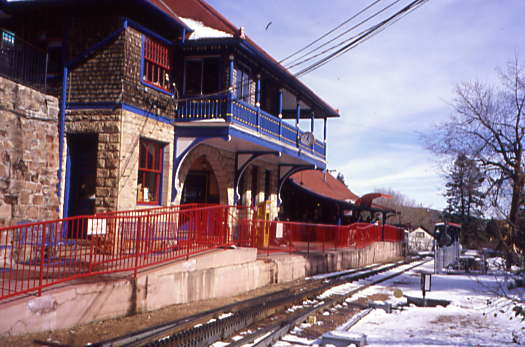
The view at track side at the station.
Shop Tour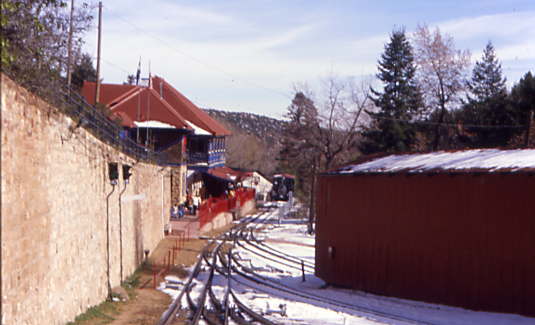
About ten minutes later, I met Spencer and we walked up to the shop for my tour.
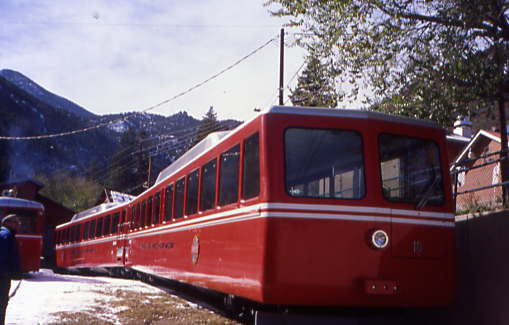
Pikes Peak Cog Railway diesel hydraulic railcar 18, built by Swiss Locomotive and Machine Works in 1975, was waiting for today's trip.
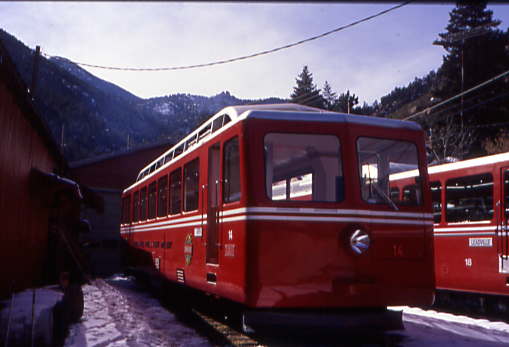
Also outside was Pikes Peak Cog Railway diesel electric railcar 14 built by Swiss Locomotive and Machine Works in 1963.
We walked inside the shop where I met the crews and learned the plan for today. A short one-car train would leave first and go to Windy Point. Our two-car train would follow and go into the siding there. Once the one-car train left, we would return to the mainline and try to go further towards the summit. After both trains had gone to Windy Point, they would drop down to 4 Mile and a rest stop for all passengers.
Walking through a door took me inside to where the cars are very well-maintained.
Two of the other railcars.
Back in the shop area, an axle being worked on.
Old cogs that had been replaced.
New cogs were on hand ready to be installed on the trainsets.
Another view inside the shop.
The drop pit had a rack hanging over it. We walked back to the station and I thanked Spencer for an interesting tour.
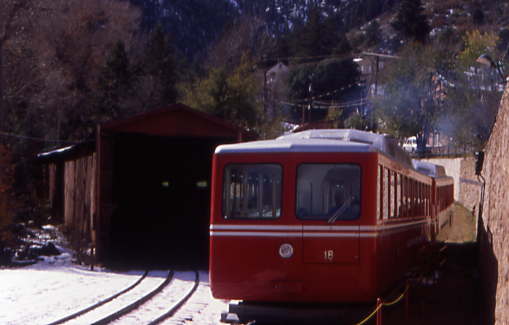
The trainsets came in with the one-car train attached to the front of our two-car set.
The RideThe passengers boarded the named cars, with Chris and I being assigned to the Leadville car in seats 7 and 8.
The short train departed at 1:20 PM while we waited for any last minute passengers. There was no morning run as the snow crews had to get out and open as much of the line towards the summit of Pikes Peak as they could. After all our passengers bboarded, we departed at 1:28 PM at 6,950 feet above sea level. Our route started climbing immediately as we passed the shop buildings then paralleled Ruxton Creek for the first few miles. The trees along here are Englemann Spruce. The tracks climbed steeply as we start passing through the first of the boulder fields.
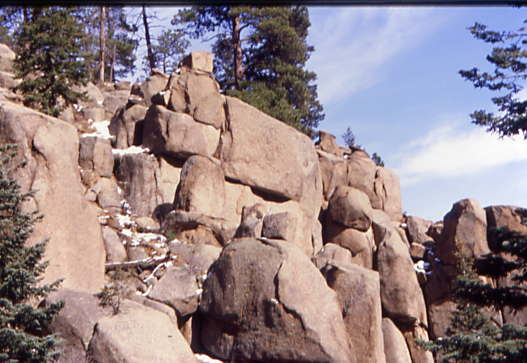
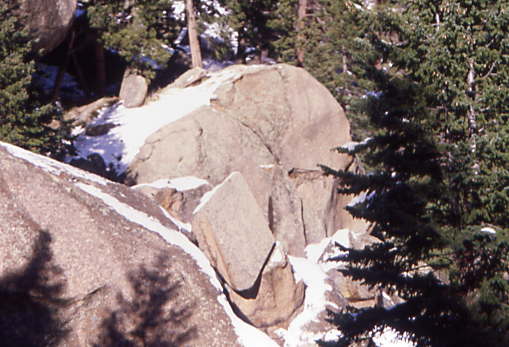
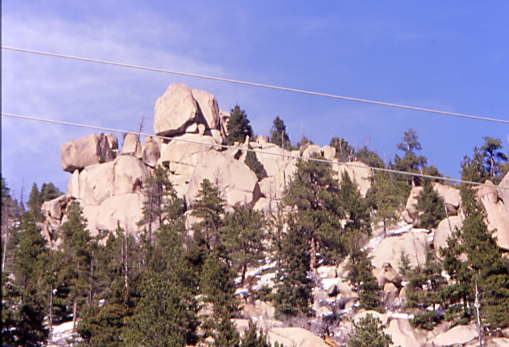
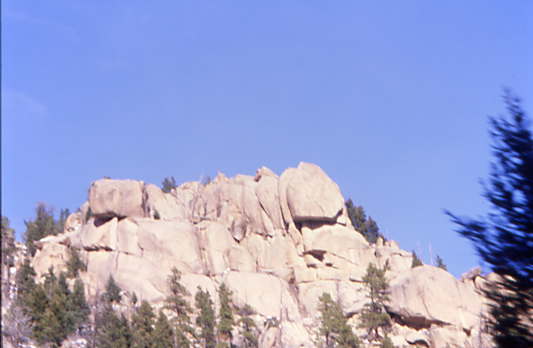
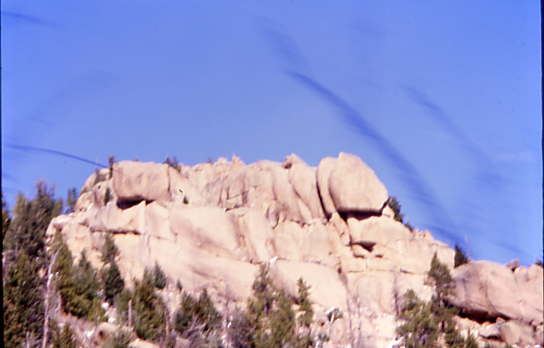
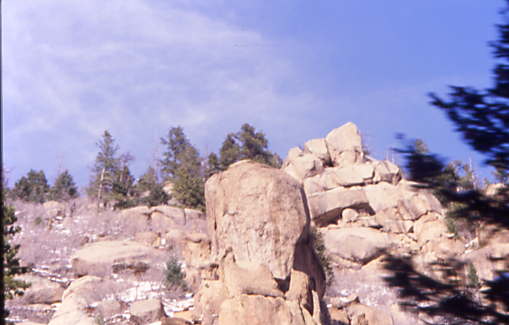
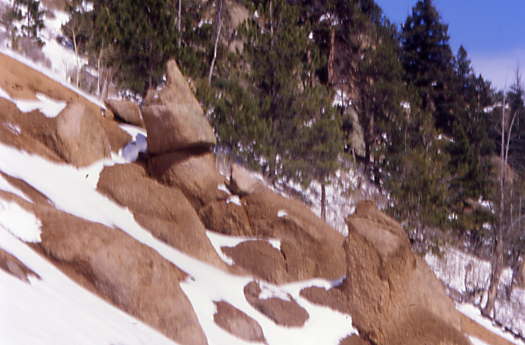
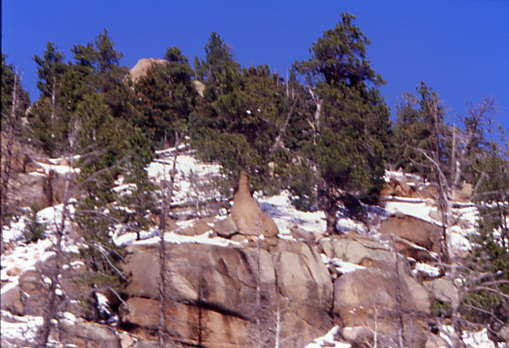
Our conductor was pointing out various boulders with names like the Sleigh or Seal Rock, as well as others. Look at these pictures and see what you can see!
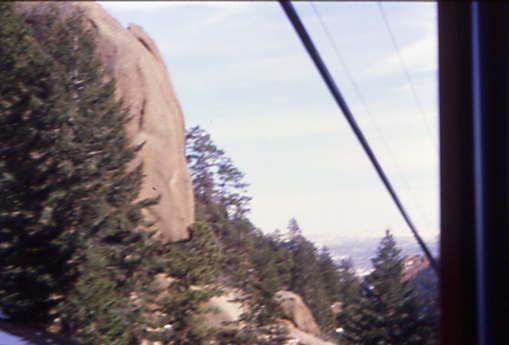
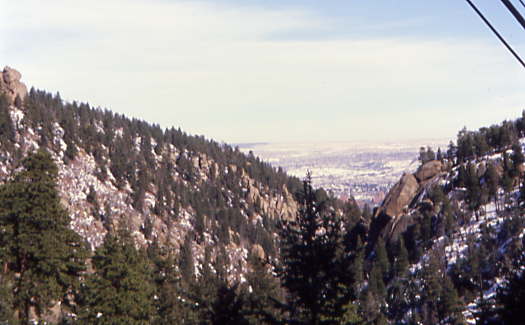
We looked back a few times towards the snow-covered Great Plains as we went through this area.
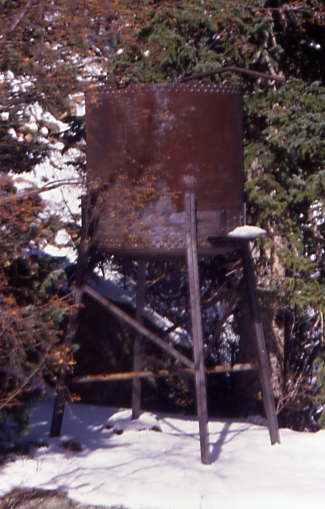
We came to Minnehaha, which is the site of a siding, water tower and a waterfall on the south side of our train then started up the very steep "Son of a Gun Hill" and through Hell Gate.
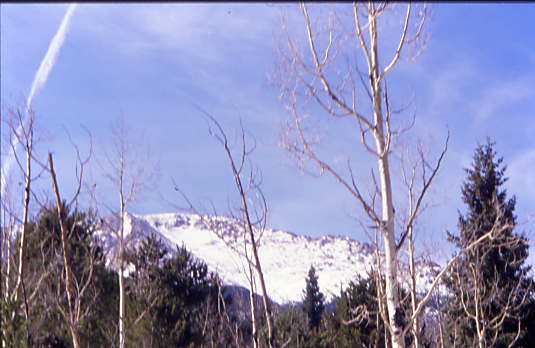
You could see Pikes Peak through the trees. The grade became gentler as we passed through Ruxton Park and Pilot's Knob.
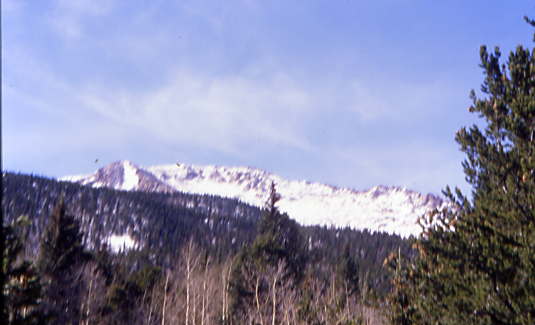
The view of the mountain nearing Deer Park.
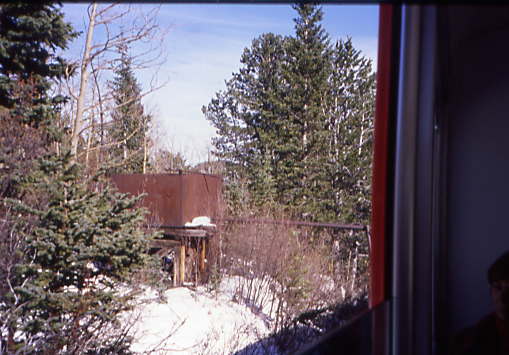
We continued climbing, reaching Deer Park before entering the longest straight track on the railroad where the water tank at Four Mile Siding is located. Further along this straight track was Mountain View at 10,000 feet before we turned and started up "The Hill" with a 24 percent grade. Below are views from the climbing of "The Hill".
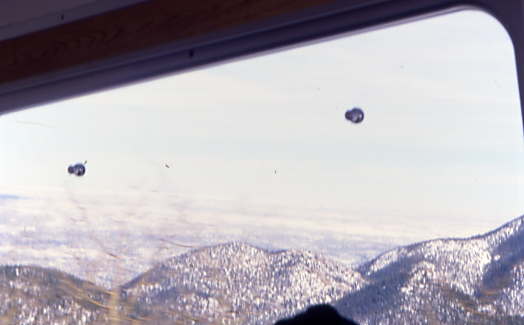
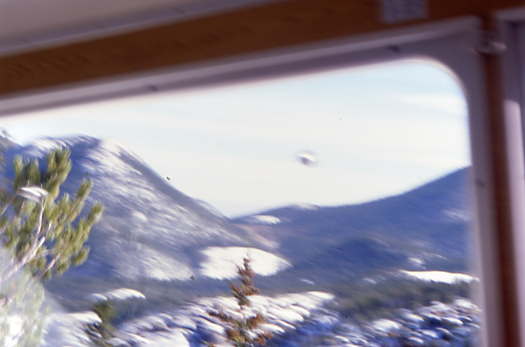
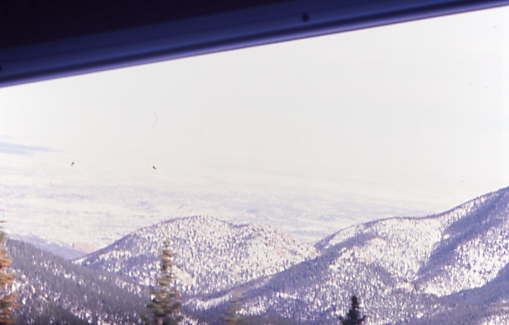
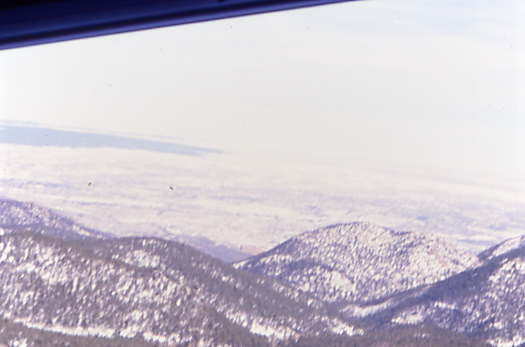
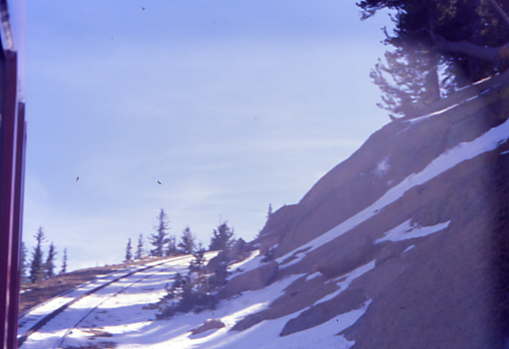
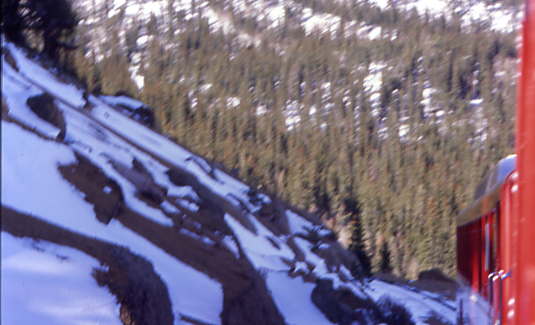
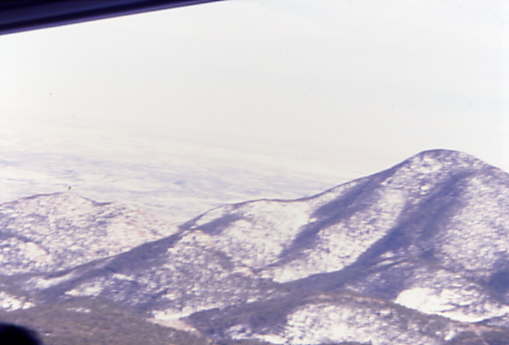
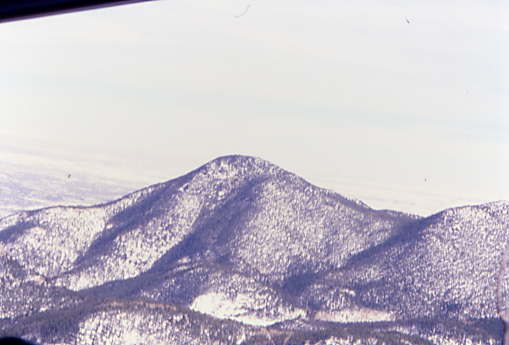
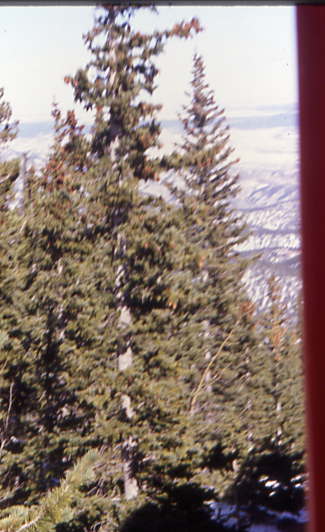
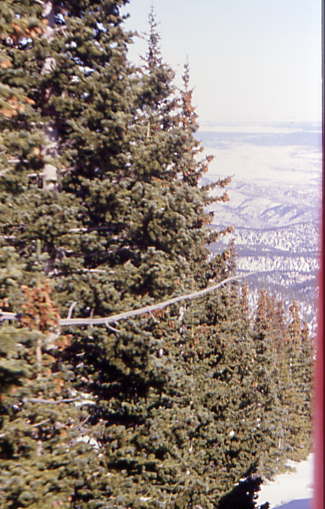
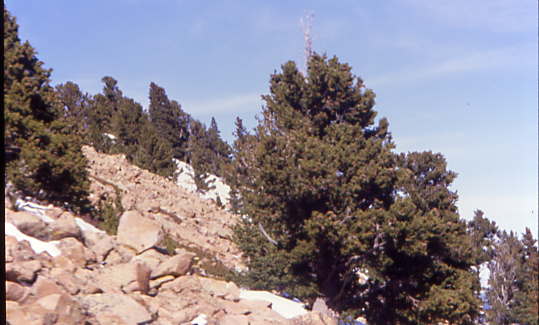
As we continued our ascent, we neared the tree line.
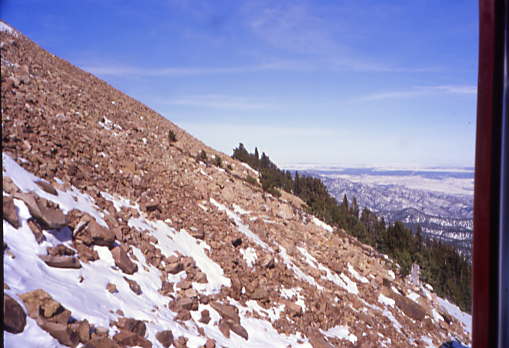
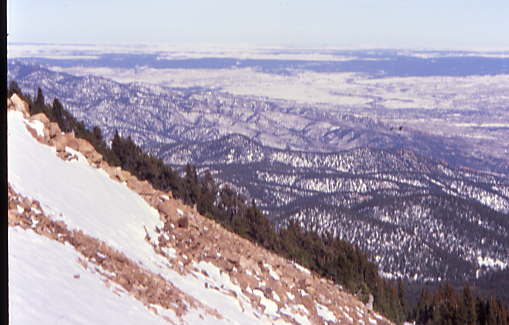
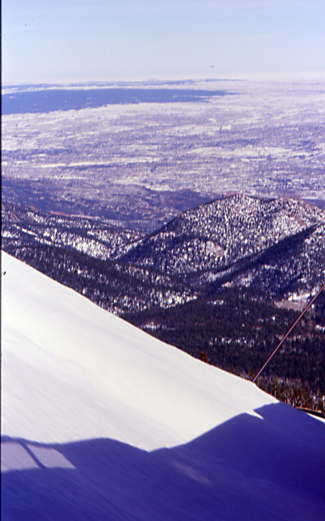
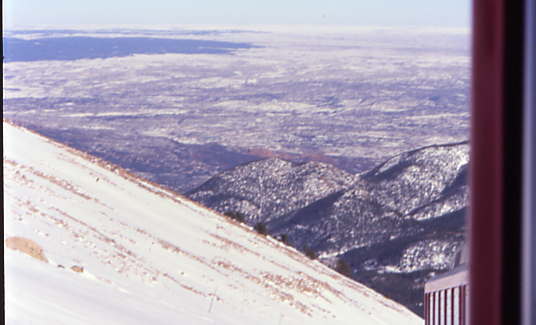
The snow grew deeper.
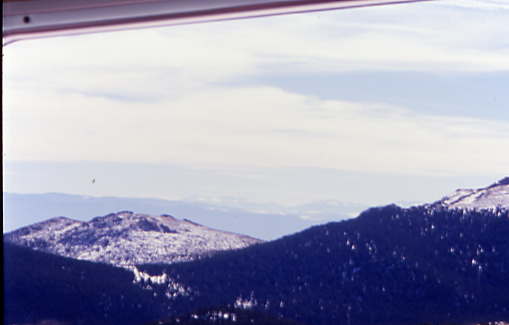
The views were stunning.

The train arrived at Windy Point, 12,130 feet where the short train was waiting for us to arrive.

An old section house. While we waited for the short train to leave, I asked the men in the first seat by the front window if they wanted to ride forward going back down and Chris and I would switch seats with them, since I wanted to photograph from the front or rear. Soon Chris and I were seated in what would become the rear of our train, but first we would try to go further up Pikes Peak.

The tracks at Windy point with the snow ahead of our train.
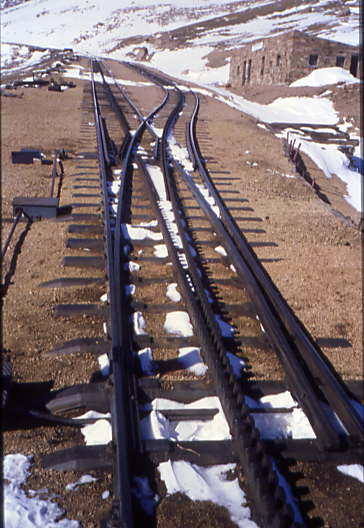
We reversed out of the Windy Point siding and after it was switched, proceeded up the track.
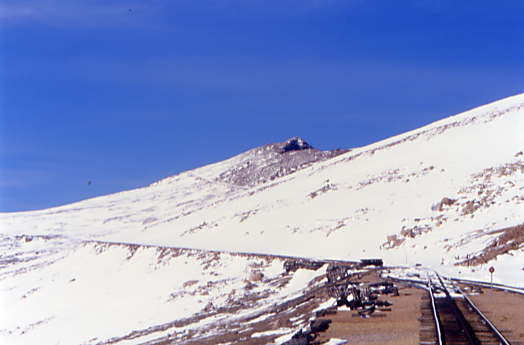
Our train approached the west end of Windy Point.
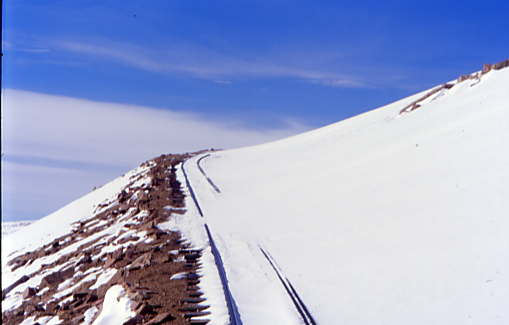
As we climbed, I had my doubts that we would be going any further.
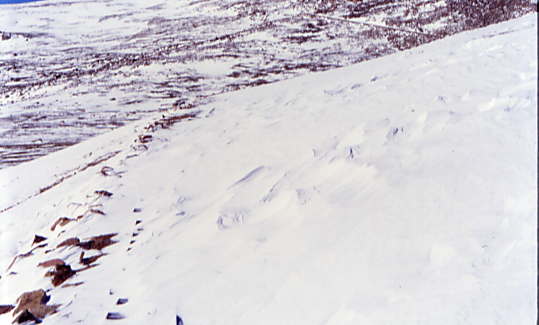
Here rails vanished into the snow.
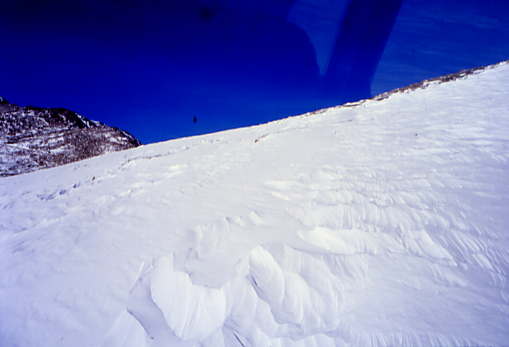
The train tried to push forward but came to an abrupt stop.
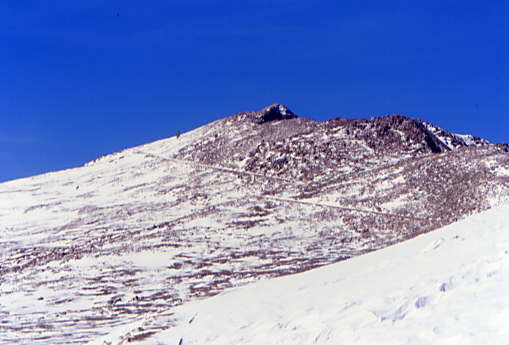
With that, I knew we would not make the summit of Pikes Peak, but it still had been a great trip.


A fantastic view from where we stopped.
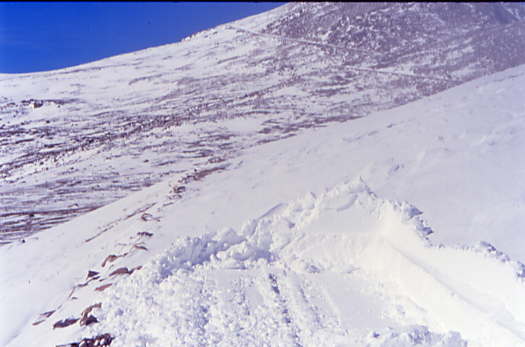
This picture shows just how much snow our train tried to go through.